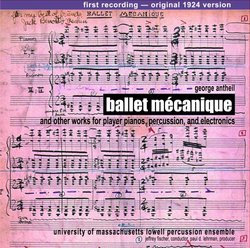If you like lots of pianos and drums...
09/03/2000
(5 out of 5 stars)
"This is the recording of the first performance of George Antheil's 1924 Ballet Mecanique for 16 player pianos, percussion, siren, airplane propellors, and bells, that has been written up in Wired, Electronic Musician, Keyboard, Mix, Sound on Sound, Piano Today, etc. etc. and was later played at Carnegie Hall and by the San Francisco Symphony. It's totally wild, and great fun. Along with the half-hour of cacophony, there are some clever player piano pieces by Richard Grayson, and percussion pieces by John Cage, Lou Harrison, and Amadeo Roldan, plus a version of a Mendelssohn symphony for 16 player pianos that will knock your socks off. A party record for high-tech types if ever there was one. (You can check out samples at http://antheil.org.)"
Great Modern Music
Brett A. Kniess | Madison, WI | 01/04/2006
(5 out of 5 stars)
"Experimental music is hit and miss on recordings, but such love and preparation was put into the making of this CD project, that it is an all-around success.
John Cage and Lou Harrison, both pretty well-known 20th century American composers, collaborated on the percussion quartet entitled Double Music. After deciding on tempo and meter, both composers completed separate sections of the same work: Cage wrote parts 1&3, while Harrison wrote parts 2&4. Scored for a battery of percussion including Water Buffalo bells, brake drums, sleigh bells, thunder sheet, water gong, etc., the piece, even though composed separately, works well when the parts are put together.
Richard Greyson, a California music professor, is represented here with two works for player piano(s) and electronic devices. Shoot the Piano Player or Shoot the Player Piano, is a throwback to the old wild-west saloons. Occasional off-beat dances and tunes come through, but it is a mish-mash of wild-west film ideas, complete with a gun fight; literally. His other work, Mr. 528, refers to the title "Mr. 88" one used to call a piano player. This work was composed for 6 piano players (multiplied by 88 gives the title) and electronic sounds. Completely tonal with unusual sound effects, the work is almost meditative with various sections of virtuosic piano flourishes.
The Cuban composer Amadeo Roldan is believed to be the first composer to write for percussion ensemble. Unfortunately, he only lived to be 39 years old. The works on this disk, Ritmicas 5 & 6, use Cuban percussion instruments, pitched and unpitched. Both evoke Hispanic dance rhythms, and while short in length, are interesting miniatures.
Additionally, on this disk, is an arrangement of Felix Mendelssohn's Saltarello movement from his Symphony No. 4 "Italian" arranged for 16 player pianos. Designed to be an expansion of Liszt's ultra-virtuosic transcriptions of orchestral works for piano, the 16 pianos playing the full orchestral score, surprisingly, isn't outlandishly ridiculous. The music from the Romantic Era is melodic and with the influence of the Italian dance, the Saltarello, is an exciting work.
The American-born composer George Antheil was interested in combining machines and classical music, an innovation of the time, and he was sorely mocked for it, and now, well-known for it. The Ballet Mecanique is a prime and famous example of this combination. Composed for 16 player pianos, 2 human played pianos, 3 xylophones, 4 bass drums, gong, 7 bells, siren, and 3 airplane propellers, the piece really was ahead of the technology and never quite worked. Today we usually hear a reduced and limited version (1952) that is less outrageous and watered-down, but thanks to the time and effort of the people on this recording project, we have probably the only original 1924 version available on CD. The CD liner notes provide many anecdotes on the failings of technology and public reactions. The music is unashamedly outlandish. Not particularly melodic, but primarily rhythmic and a-tonal, the pianos have huge glissandos and cluster chords, the xylophones have virtuosic moving lines, and the percussion gives the work the metrical and important timbre qualities. The sounds of buzzers, bells, and propellers just add to the chaos. Metrical times include 64/4, 7/32, and 10/16, and at a length of 30 minutes, the work ends up almost having a "mantra" or meditative feeling once you get into it, interestingly enough. The last few minutes uses varying units of silence as opposed to the first 20+minutes of unrelentless wash of sounds. Not something everyone will want to listen to, it is historically important, and a unique composition.
As mentioned before, experimental music usually loses something on record, but this CD of various premiered versions of 20th century music is a success. Please make sure you like this type of music before buying. A good buy for the rest of us."
One of my favorite CDs of all time
parisNewt | 06/11/2009
(5 out of 5 stars)
"Nothing equals the sheer madness of the Ballet Mecanique in this insanely loud and precise version. Some of the other tracks are also wildly entertaining. A top ten disc!"


 Track Listings (7) - Disc #1
Track Listings (7) - Disc #1